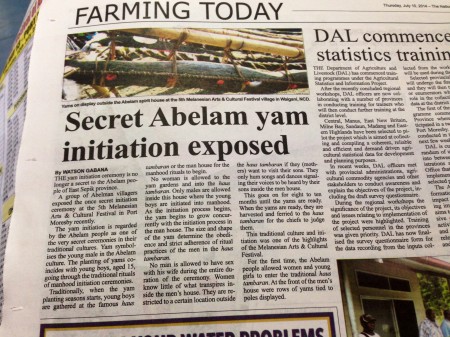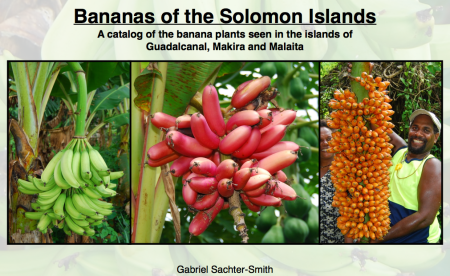- Asian genes in European pigs are a good thing.
- How about American pigs though?
- Great Spanish language cacao infographic. And more along the same lines.
- Innovative apple family farming in the Tyrol.
- Not sure that will be much use in terms of global food security, as per this recent review, but you never know. Because, you know, climate change?
- Well, there’s always wild food. Though in some places more than others.
- Student videos on the origin of food plants.
- But did any of them change their lives?
- Oxfam thinks teff can change lives.
- Different part of same continent, different grain to revitalize.
- Different continent, different grains to revitalize.
- Bah, who needs cereals when you have indigenous vegetables?
- Wait, what? Seedless mangoes? Why is this not first-page news?
Brainfood: Agricultural anthropology special edition, Breeding gourami, FGR indicators, Solanum phenomics, Organic aphids, Restoration genetics, Wild Vigna, Genebanks & genomics
- Tending the Field: Special Issue on Agricultural Anthropology and Robert E. Rhoades. Agrobiodiversity conservation, participatory and collaborative research, and the politics of agricultural development.
- Genetic Diversity of Siamese Gourami from Sumatra, Java and Kalimantan for Selective Breeding of Fish Culture. Yeah, but does it taste nice? Time for some fishicultural anthropology, methinks.
- Global to local genetic diversity indicators of evolutionary potential in tree species within and outside forests. You can’t use indirect indicators of pressure, benefit or response independently of state indicators for genetic diversity. Anyway, here’s a bunch of all of those for you to ponder.
- Conventional and phenomics characterization provides insight into the diversity and relationships of hypervariable scarlet (Solanum aethiopicum L.) and gboma (S. macrocarpon L.) eggplant complexes. High-throughput phenotyping platform built for tomatoes distinguishes between really variable complexes of other solanaceous berries.
- Organic vs. conventional farming dichotomy: Does it make sense for natural enemies? Yes.
- Genes are not information: Rendering plant genetic resources untradeable through genetic restoration practices. Decommodify to commodify. No, really.
- Prioritising in situ conservation of crop resources: A case study of African cowpea (Vigna unguiculata). 9 of 13 priority wild cowpea taxa are likely to be found in protected areas.
- Genebanks and genomics: how to interconnect data from both communities? Beyond databases.
Nibbles: Prof. Mithen, Commons, Park Grass, Maize genome dupe, Training breeders, Insect-eating fungi, Shea, Teff breeding, Cannabis genome, Organic study, Old sunflower domestication, Rick’s tomatoes
- Developer of super broccoli reflects on his career. With photo of collectors in NSFW shorts.
- Touring the commons of the world. Thankfully no tight shorts in sight.
- Video explaining Rothamsted’s Park Grass experiment. Apparel entirely acceptable, don’t worry.
- Ten million-year-old genome duplication finally came good when ancient farmers domesticated maize.
- Training materials for African breeders to be developed.
- Fungal diversity to the rescue of plants, for a change.
- Africa’s black soap.
- Improving teff. That’s a low bar, I suspect.
- A genome I’m sure we can all get behind.
- Oh dear, that organic meta-analysis “flawed” after all. Will it ever end?
- Rethinking sunflower domestication. An oldie but goldie, which re-surfaced today for some reason. Does anyone know where we are with this now?
- The Deliverance of tomatoes.
Yam secrets revealed
I ran across an interesting article in The National newspaper last week in PNG, but I can’t find it online, so I’m posting a scan of it below. You should be able to read it ok if you click on it. It’s worth it. How can anything with the title “Secret Abelam yam initiation exposed” not make for fascinating reading.
The Abelam people are from East Sepik province and their life — especially the life of the men — revolves around yams:
Among the Abelam, the yam cult is a unique cultural institution and the focus of male existence. It involves men striving to produce long tubers (up to a length of 6 feet/180 cm or more), in intense competition with a long term partner in a neighbouring village. There are two major ritual cycles in Abelam life, both centred on this cult — initiation ceremonies which instruct young men in the magic and skills required to grow the prized long yams, and yam growing ceremonies and rituals designed to ensure the success of the current crop.
There are also yam festivals after harvest:
The actual yam displays are very festive occasions. Yam growers from rival villages generally arrive together on the morning of the event. When they are all gathered, the yams, which have been concealed behind barriers and decorated with shell, feather, and basketry ornaments, are carried onto the ceremonial ground. Each waapi is attached to a pole, and carried by two men, one at each end. As the yams are paraded, guests show their approval of their rivals’ efforts by putting special leaves (naarendu) or lime on particularly good specimens. Subsequently the waapi are lined along wooden frames in front of the ceremonial houses where they are carefully inspected and measured by ritual exchange partners. Following the inspection, rivalrous songs, particularly on the themes of yam exchanges and warfare, are sung by individuals. Groups and individuals may claim victory in these song contests by virtue of “evidence” and superior oratory.
It all sounds very spectacular. And extremely important:
…ceremonial yams have an important political function: to a large extent, male status, prestige, and power are dependent on the size and quality of ceremonial yams grown.
In addition to their importance in the political arena, “long yams” have considerable expressive content. Since all yams are propagated vegetatively, yams also form a link between living Abelam men and their ancestors, who planted genetically identical yams. Abelam often invoke their ngwaalndu (clan ancestral spirits) when growing and tending yams. The link between a man, his ceremonial yams, and his ngwaalndu is very close. Yams are of paramount social, symbolic, and religious importance to the Abelam people.
The species involved are Dioscorea alata (waapi) and D. esculenta (jaambe). These are under pressure in some parts of Papua New Guinea, being replaced by recently introduced African species, which seem to withstand pests, diseases and drought somewhat better, I was told. This doesn’t yet seem to be the case for the Abelam, but I wonder for how long. Maybe aeroponics is the answer?
Bananas galore
Rosa would certainly have welcomed a great new 1 catalogue of some 50 banana varieties from the Solomon Islands by Gabriel Sachter-Smith, put out by ProMusa. The varieties on the cover are Broken Heart, Ruhuvia Chichi and Ba’u Lalao.
Oh, and there’s also a new wild subspecies from India.

